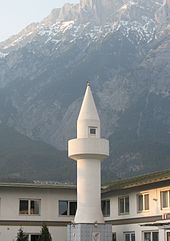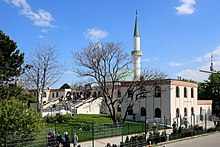Mosques and Islamic prayer rooms in Austria
In 2017 there were more than 400 Islamic prayer rooms and mosques in Austria .
history
The Islam in Austria is since 1912 recognized religious society (the first Islamic law , at the time the Muslim part of Bosnia-Herzegovina to the Austro-Hungarian Empire , and this very Austria friendly country should be fully integrated). Since then, the religious community has had all the rights to publicly practice religion , in particular to operate its own public houses of prayer (private freedom of religion has existed since 1781).
The oldest mosque in Austria is the Islamic Center in Vienna's 21st district, Floridsdorf . The mosque was built between 1975 and 1979 and was financed with funds from the then King of Saudi Arabia, Faisal ibn Abd al-Aziz . The property was bought in 1968 by representatives of eight Islamic states. The dome of the mosque has a diameter of 20 meters and the minaret is 32 meters high. The first major new building in the rest of Austria was the Eyüp Sultan Mosque in Telfs, Tyrol (1998). Another mosque was opened in Bad Vöslau on October 24, 2009 , the Hacı Bayram Mosque . A fourth larger mosque has been under construction in Graz since 2012 ( Islamic Cultural Center Graz ) .
To separate the mosque and prayer room
The Islamic Faith Community in Austria (IGGiÖ) itself distinguishes between mosques and prayer rooms: In total, IGGiÖ has a good 200 registered prayer rooms (as of the end of 2014). These are mostly simple rooms that were housed in apartments or former warehouses or factories. In contrast to prayer rooms, mosques have to be built as such and cannot be created by rededicating a building. In addition, a mosque must be open during prayer times. Mosques are generally comparable to the Christian community center , i.e. more comprehensive complexes of prayer hall and adjoining rooms, and serve as a "place of gathering, assembly and communal prayer, as a versatile meeting place and as a social, cultural, theological-educational and religious center".
reception
Since the mid-2000s, the construction of mosques has been the subject of increased political debate. Since the Islamic religious societies had established numerous assembly centers since the 1970s, and the construction and operation of mosques per se as a recognized religion was constitutionally entitled, the discussion was primarily reduced to the appearance of new buildings and the subsequent marking of existing assembly centers with minarets (minaret dispute) . Since 2003 there has been an eight meter high minaret near the Selimiye prayer house in Saalfelden , in the Pinzgau region of Salzburg. In addition, because the community is well integrated there and the building is inconspicuous in the townscape, there was no public excitement. However, in 2005 there were disputes that were perceived nationwide about the minaret in Telfs .
The FPÖ and BZÖ have repeatedly called for a ban on the construction of mosques and minarets. In February 2008, the Carinthian provincial government decided to create its own special commission to maintain the local landscape in order to prevent the construction of mosques in Carinthia. Together with the ÖVP , the FPÖ and BZÖ passed laws in Carinthia and Vorarlberg for the supervision of Islamic religious buildings under building law. The SPÖ and the Greens generally oppose such bans.
Tyrol

As early as 2005 there was a locally controversial application for the construction of a mosque in Telfs. In 2006, the local mosque community added a minaret to a mosque that had existed since 1998. Opponents of the building collected 2,500 signatures against the original plans for a 20 meter high minaret, whereupon Mayor Stefan Opperer approved the construction of the minaret subject to a ban on sound. The height of the minaret was reduced to 15 meters.
Carinthia
In August 2007, the Carinthian Governor Jörg Haider (BZÖ) announced that mosques and minarets in Carinthia would be declared as disturbing the appearance of the village and that their construction would be prevented by means of special dedications. Haider justified the measure with the "fight against radical Islamism and the protection of our western dominant culture." A legislative initiative of the BZÖ in September 2007 to ban mosques and minarets initially failed, whereupon Haider threatened a referendum on this topic. The Carinthian Landtag commissioned the provincial government, with the votes of the BZÖ, ÖVP and FPÖ and against the votes of the SPÖ and the Greens, to submit a legislative proposal to ban mosques and minarets. The corresponding law was passed on February 12, 2008 by the BZÖ and ÖVP against the votes of the SPÖ in the state government. In order not to violate the constitutionally established freedom of religion, no direct construction ban on minarets and mosques was passed. Rather, the construction of mosques is to be prevented by the creation of a site maintenance special commission. This special commission for the maintenance of the townscape is to check whether unusual building projects "fit into the established townscape". An expert opinion submitted by the special commission for the maintenance of the site is binding for the municipality board concerned as the first building authority. If the municipality disregards the commission decision, the matter comes into the competence of the state, the final decision is incumbent on the administrative court.
Vorarlberg
The Carinthian discussions, and in particular the Swiss minaret dispute that has been going on since 2007 , with the ban on building minarets anchored in the constitution through a referendum in 2009 (popular initiative “Against the construction of minarets”), also had an impact on Vorarlberg. In August 2007 Governor Herbert Sausgruber (ÖVP) was "with a certain skepticism" about the construction of minarets, but considered a general construction ban to be incorrect and constitutionally unenforceable. As a result, the FPÖ and BZÖ demanded the implementation of a mosque construction ban in Vorarlberg, the BZÖ founded its own citizens' initiative for this purpose. There was also a discussion about a mosque with a minaret planned in Bludenz . Finally, Governor Sausgruber also spoke out in favor of tightening the spatial planning law so that such building projects can only be built in agreement with the municipalities. On February 25, 2008, the ÖVP-FPÖ state government finally presented a draft law that should regulate the construction of minarets. For this purpose, the new dedication category "high-profile venues" should be created, which applies to mosques, minarets, churches, discos, cinemas and similar buildings in built-up areas. Anyone who wants to erect such buildings needs a special dedication from the municipal council. The state is then responsible for stipulating that certain projects must be assessed by an official expert with regard to the appearance of the site. The state thus has a say in local construction projects. At the beginning of April 2008, the Vorarlberg state parliament finally passed a law that placed "facilities for cultural purposes" and the construction of "public-intensive event venues" under a special right of dedication. The law is intended to prevent mosques with minarets from being built without violating the constitutional right to religious freedom. In August of the same year it became known that the ATIB association, which had previously applied for the construction of a mosque in Bludenz, had refrained from planning to build a minaret.
Vienna

There are problems with the Islamic Center in Dammstrasse in Brigittenau, which has been established by the Turkish-Islamic Union for Cultural and Social Cooperation in Austria (Atib) since 2013 . There is a citizen's initiative mosque goodbye , which has been fighting against the expansion of the center for years.
Attitude of the Catholic Church
Cardinal Christoph Schönborn spoke out clearly against building bans on mosques in March 2008 , as he could not see any problems in the buildings. The former Vorarlberg bishop Elmar Fischer, however, described the construction of mosques with minarets in Austria as a “provocation” that would represent a blatant threat to social peace. According to Fischers, immigrants must first integrate to a greater extent before society can accept the construction of mosques. His predecessor, St. Pölten Bishop Klaus Küng , supported Fischer in his concern. According to Küng, Muslims should refrain from building mosques as long as churches are prohibited in Islamic countries.
See also
literature
- Josef Peter Schuller: The hidden mosque. On the Visibility of Muslim Prayer Rooms in Vienna , ed. Ulrike Bechmann / Wolfram Reiss: Application-oriented religious studies, contributions to social and political issues , Volume 4, Tectum, Marburg 2013, ISBN 978-3-8288-3177-3
Web links
- Registered mosques . Islamic Faith Community in Austria, derislam.at - current list of recognized religious communities
Individual evidence
- ↑ Islamic religious community counts mosques in Austria. In: derstandard.at. July 21, 2017, accessed January 31, 2018 .
- ^ Islamic Center. ( Memento of the original from May 3, 2007 in the Internet Archive ) Info: The archive link was inserted automatically and has not yet been checked. Please check the original and archive link according to the instructions and then remove this notice. wien.info.
- ^ Mosque opened in Bad Vöslau. In: ORF Lower Austria . October 24, 2009, accessed May 1, 2020.
-
↑ islamgraz.org ;
Mosque in Graz is growing slowly. In: Die Presse online, May 27, 2013. - ↑ a b c Carla-Amina Baghajati, spokeswoman for the Islamic Faith Community in Austria, quoted in the background: Do mosques have to have minarets? Die Presse Online, August 24, 2007.
- ↑ Quote (with omissions) Mosque / House of God: The mosque, the Islamic house of God. moschee-saalfelden.at, accessed March 5, 2015.
- ↑ The minaret that nobody knows. Die Presse Online, December 5, 2009
- ↑ Telfs: Minaret before completion. (No longer available online.) In: tirol.orf.at. June 14, 2006, formerly in the original ; accessed on April 20, 2018 . ( Page no longer available , search in web archives ) Info: The link was automatically marked as defective. Please check the link according to the instructions and then remove this notice.
- ↑ Carla-Amina Baghajati, spokeswoman for the Islamic Faith Community in Austria, quoted in the background: Do mosques have to have minarets? Die Presse Online, August 24, 2007.
- ↑ Protect the leading culture. Haider: building ban on mosques and minarets. ORF Carinthia, August 26, 2007
- ^ Building ban for mosques: Haider failed for the time being . ( Memento from October 18, 2014 in the Internet Archive ) Kleine Zeitung Online, September 14, 2007
- ^ Government meeting. State government decides to ban minarets . ORF Carinthia, February 11, 2008
- ↑ Reactions: Sausgruber: “I am skeptical about minarets” . Die Presse Online, August 28, 2007
- ↑ LH wants to change the spatial planning law . ORF Vorarlberg, January 24, 2008
- ↑ Vorarlberg prevents minarets by law. Der Standard Online, April 9, 2008
- ↑ Changed plans: No minaret in Bludenz . ORF Vorarlberg, August 14, 2008
-
↑ Small minority: black people who pray to Allah. Clara Akinyosoye in Die Presse online, June 22, 2010;
Groundbreaking: Islamic cultural center is built. Duygu Özkan in Die Presse online, May 27, 2013. - ↑ Schönborn understands the ban on veils in the process . ORF Vienna, March 16, 2008
- ^ Bishop: "Minaret endangers social peace" . ORF Vorarlberg, March 18, 2008
- ↑ Schwärzler and Küng agree with Bishop . ORF Vorarlberg, March 19, 2008
